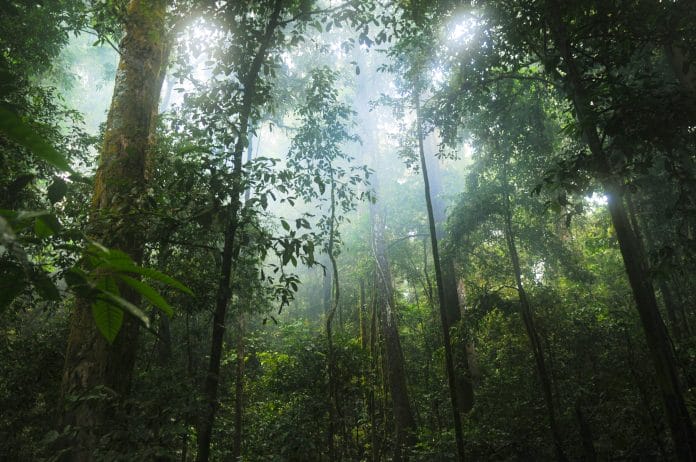By: Dr. Rulia Akhtar, Research Fellow at the Ungku Aziz Centre for Development Studies (UAC), Universiti Malaya
The rainforest is the heart of our world, not merely a stunning location. The well-being of our world and the splendour of its many species are both greatly enhanced by the rainforest. Tropical rainforests, which occupy around 6% of the Earth’s surface, are essential to the ecosystem of the planet since they are home to almost half of all plant and animal species. In addition to providing oxygen, the rainforest regulates the temperature, cleans the water, and maintains pure air. Millions of people can also get food, medicine, and other necessities for a better life from a rainforest.
For a fair price, these forests store carbon in expansive, towering, undisturbed hardwood forests for all time. Huge volumes of carbon are kept from being emitted by these massive trees by the enormous amounts of carbon they store in their wood, roots, and soil. The world’s woods take in a net 7.6 billion metric tonnes of CO2 annually. One of nature’s strongest shields against climate change is the rainforest. Tropical rainforests perform better than other types of woods at storing carbon dioxide and storing it. Rainforests serve as important carbon storage and sequestration systems. They are the world’s greatest terrestrial carbon sinks, absorbing around 2 billion tonnes of CO2 annually. They use photosynthesis to collect and transform atmospheric CO2 into biomass. The sequestered carbon is then maintained by living trees, deadwood, litter, and forest soils, resulting in a worldwide carbon “reservoir” that serves to offset the consequences of global warming.
The rainforests of Malaysia are among the world’s greatest diverse. A vital component of the ecology, forests support a varied ecosystem of plants and animals, safeguard water and soil resources, and help to stabilise the climate. The rainforests of Malaysia are home to an array of wildlife, comprising nearly 200 mammal species, such as the endangered Malayan tiger, Asian elephant, Sumatran rhinoceros, Malayan tapir, gaur, and clouded leopard. Additionally, the region hosts over 600 bird species and 15,000 plant species. Of these plant species, thirty-five percent are unique to this planet.
Malaysia committed to preserving at least 50% of its total land area as forests in 1992, during the Rio Earth Summit, in order to guarantee the long-term viability of our forests. Nearly three decades later, we still have not broken that promise because, as of right now, woods span 18.27 million hectares, or 55.3% of the country’s total land area. 3.31 million hectares of this total wooded area are completely protected regions, while 10.92 million hectares are Permanent Reserve Forests. This demonstrates the determination and dedication of the country to preserve and responsibly manage our forest, its wildlife, and its flora. In addition, the forests offer a wide range of other beneficial resources, such as food, fibre, and lumber in addition to medicinal plants. The forests are an essential economic pillar that, with proper management, can sustainably support our country for all time. We all use these forest-based commodities on a daily basis, even though we typically don’t realise how inextricably interwoven forests are to our way of life.
Therefore, it is essential to manage and use these resources sustainably in order to prevent climate change and to promote the prosperity and well-being of Malaysians today and in the future. Malaysia is committed to sustainable, socially, and environmentally sound forest management in order to ensure the long-term health of its forests and forest products and meet the growing demand for sustainable timber on the international market. The country is making a concerted effort to meet the 2030 Sustainable Development Goals set forth by the UN.
In order to achieve this, the nation practices environmental protection and conservation through a variety of initiatives based on sustainable forest management, such as the creation of forest plantations to lessen the strain on our natural forests in order to provide a steady supply of raw materials for the logging industry.
Compared with different kinds of forests, tropical jungles retain more carbon and are crucial for habitat. These woods are found in tropical areas like Malaysia and have existed for many years. A continuous loss of species and a discharge of formerly stored carbon into the environment result from the destruction of such forests. As they grow, the trees in rainforests take up and store a lot of greenhouse gases. Tropical forests are essential to the fight against climate change because of their ability to sequester carbon. The effect of climate change is exacerbated when these woodlands are lost or damaged because carbon that is stored gets released to the environment.
They are the global regulators of the water cycle. Rainforests contribute to the global water cycle through transpiration. Trees produce water vapour into the atmosphere, which causes precipitation and clouds to form. This can have an impact on local and worldwide weather patterns. In addition to controlling humidity and temperature, their dense canopy affects local and regional climates. Additionally, rainforests provide economic benefits. More than a billion people directly depend on rainforests for their livelihoods; they rely on these ecosystems for a variety of commodities, including food, medicine, and timber.
For thousands of years, indigenous tribes have flourished in and around these forests, and their cultures are intricately entwined with these natural settings. Plants found in rainforests have been the source of many modern medications. Rainforests may yield medical discoveries in the future due to the large number of undiscovered species. Minimising carbon footprints is one way to help preserve rainforest ecosystems. This includes things like reducing trash, promoting recycling, investing in carbon offset projects that help the preservation of rainforests, and implementing energy-efficient business practices.
Organisational leadership must be genuinely committed to sustainability and make a commitment in order to implement these measures. As environmental consciousness rises to previously unheard-of heights, companies who support rainforest protection benefit the environment as well as their brand, which appeals to consumers who care about the environment. It’s critical to recognise that rainforests cannot provide all the answers. Even if they contribute significantly, they cannot stop climate change on their own. It is imperative to take a holistic strategy that incorporates lowering greenhouse gas emissions, switching to renewable energy sources, and implementing sustainable agriculture methods.
Therefore, it is crucial for the welfare of future generations to acknowledge the significance of rainforests and act to protect them.









